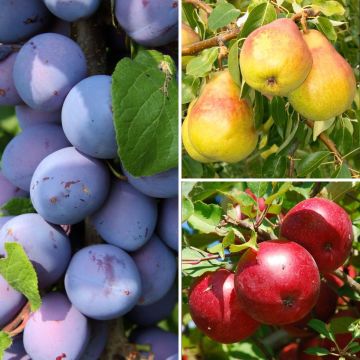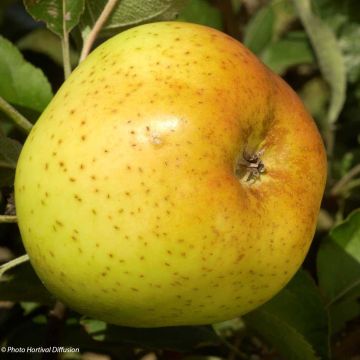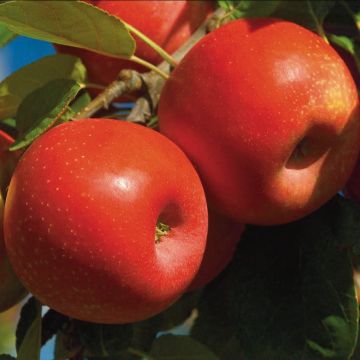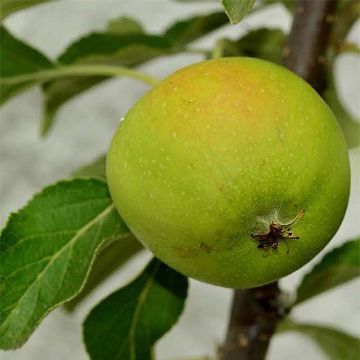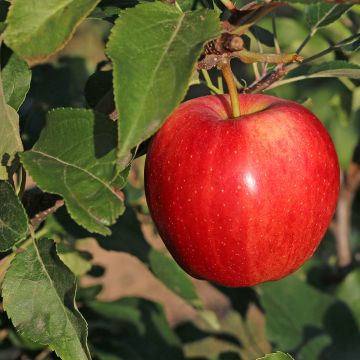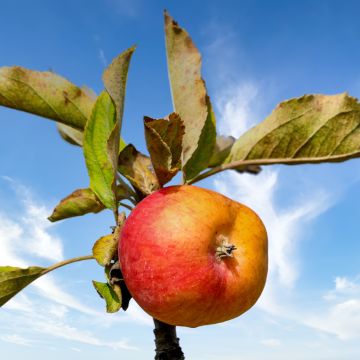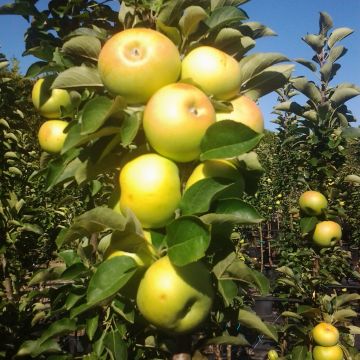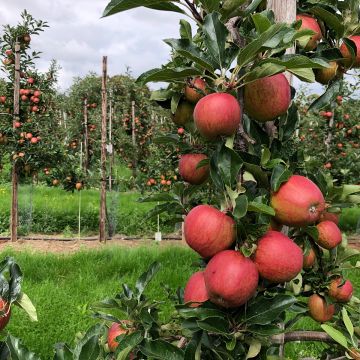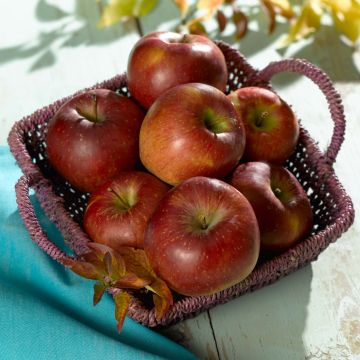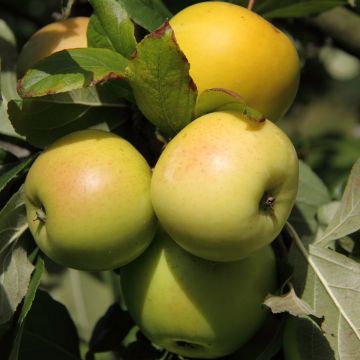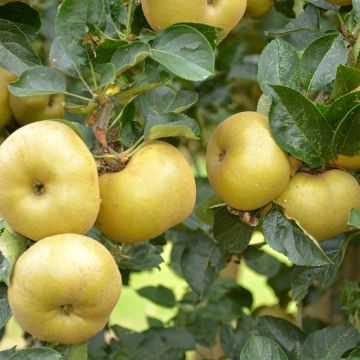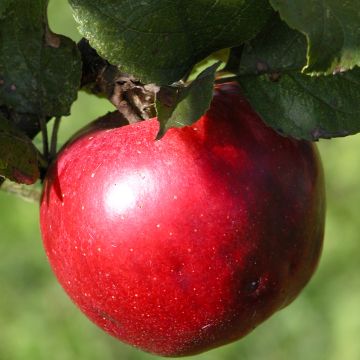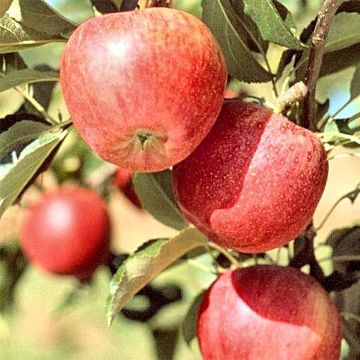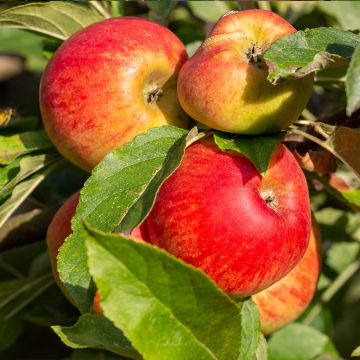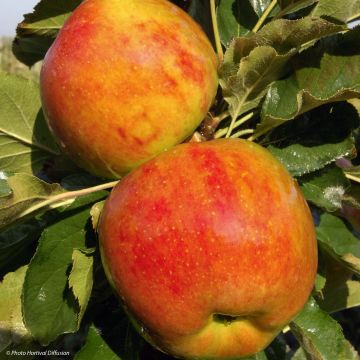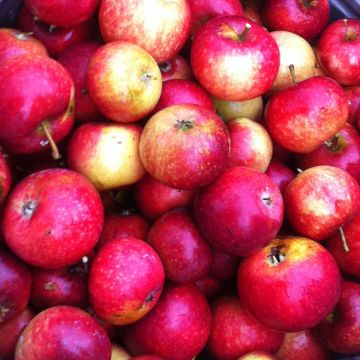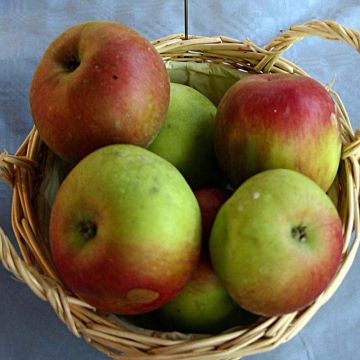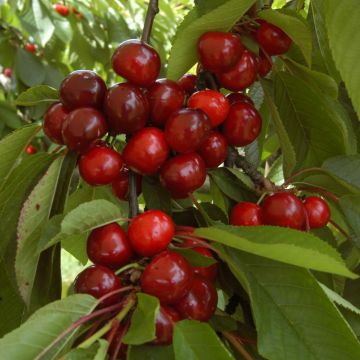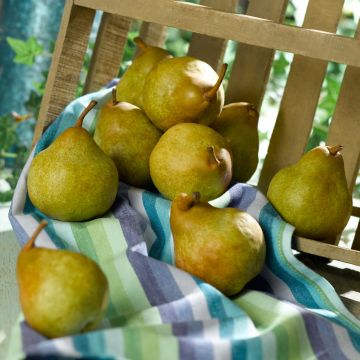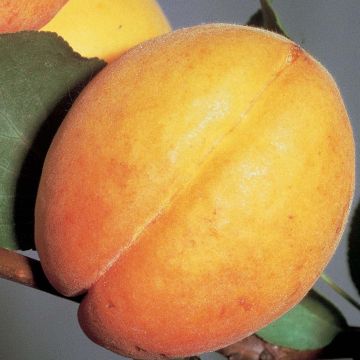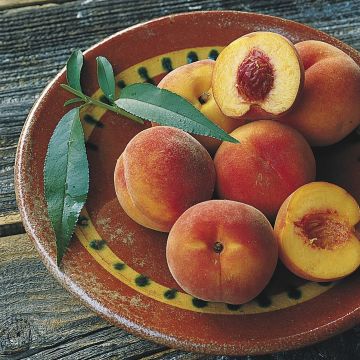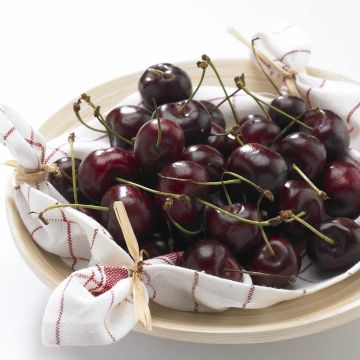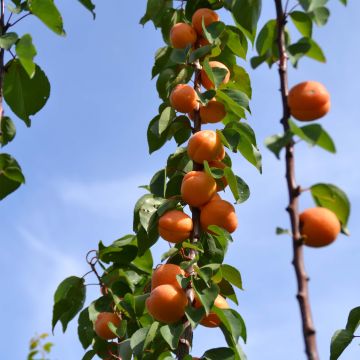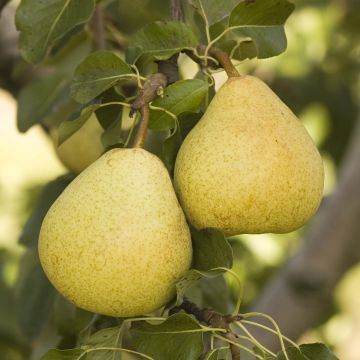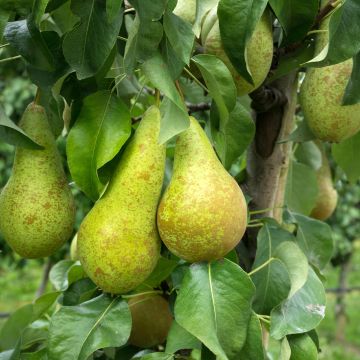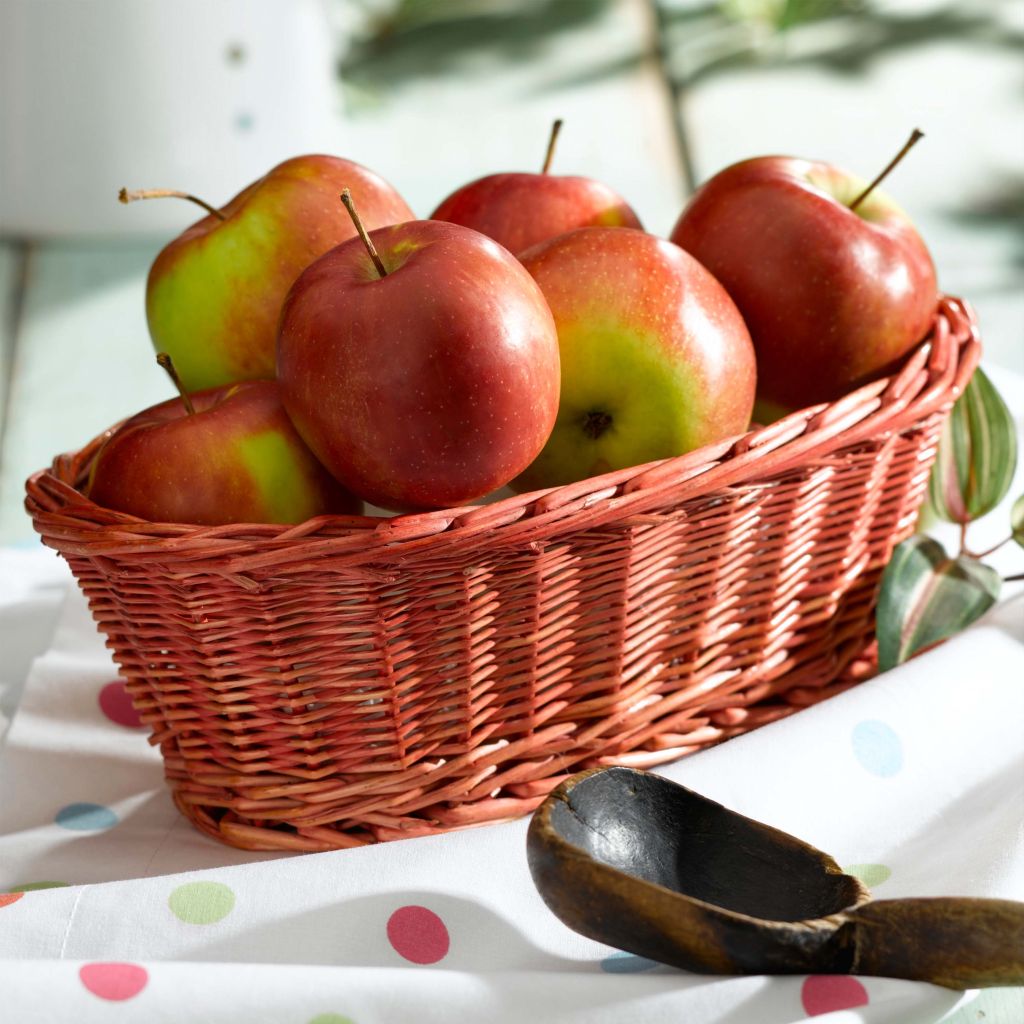

Pommier Pomme des Moissons - Georges Delbard
Apple Tree Harvest Apple - Georges Delbard
Malus domestica Pomme des Moissons® Delprivale
Apple, Orchard apple, Table apple, Cultivated apple
Emballage mal fermé avec carton humide qui se désagrège et terreau qui se répand. Une branche cassée du pommier. Globalement satisfait des plants fournis Cdt
Christian M., 10/12/2018
Why not try an alternative variety in stock?
View all →This plant carries a 6 months recovery warranty
More information
We guarantee the quality of our plants for a full growing cycle, and will replace at our expense any plant that fails to recover under normal climatic and planting conditions.
Oversize package: home delivery by special carrier from €6.90 per order..
Express home delivery from €8.90.
Description
The Delprivale Harvest Apple Tree is a variety that stands out for its early character as it is harvested in summer, from the end of July to August. Vigorous and productive, this apple tree produces yellow apples with red colouring. Their flesh is juicy, perfectly balanced in flavour between sweet and tangy, with a pleasant hint of anise.
The Delprivale Harvest Apple Tree is a delicious and refreshing apple. It is best enjoyed immediately after harvest as it does not keep for long, a maximum of one month.
Hardy, this apple tree can withstand temperatures as low as -20 °C (- 4°F) and blooms in April. It is a reasonably disease-resistant variety.
This apple tree is not self-fertile, so in the garden, it should be planted near varieties that bloom simultaneously, such as 'Reine des Reinettes', 'Royal Gala', or 'Delbard Jubilé' to ensure pollination.
The apple tree (Malus domestica) is a fruit tree that belongs to the Rosaceae family. It is cultivated almost everywhere in the world and includes countless ancient and modern varieties that produce apples of varying sizes and flavours, ranging from sweet to tangy.
Apple trees are native trees in Europe, and their presence has been documented since antiquity. Hardy, some varieties can withstand temperatures as low as -30 °C (- 22°F), and they can be grown almost anywhere.
The pruning of the domestic apple tree does not exceed ten meters in height and width. The size can be even smaller depending on the rootstock's vigour. This fruit tree usually has a tall trunk that naturally spreads out. It can take different forms (bush, half-standard, standard, etc.) and be trained in various ways (column, cordon, espalier, etc.).
The apple tree leaves are deciduous and arranged alternately on the branches. Their lamina is ovate and dentate. They have a dark green upper surface and a whitish lower surface, slightly fuzzy.
In spring, the apple tree bears white or pinkish-white flowers grouped in corymbs. The flowers of the apple tree consist of 5 petals; these white flowers surround a core composed of about 20 stamens. They give rise to fleshy fruits (drupes, botanically speaking), spherical and filled with pips. Their colour, size, flavour, and shelf life vary depending on the variety.
Rarely self-fertile, the apple tree is a fruit tree that requires the presence of other apple trees, blooming simultaneously and nearby, to bear fruit.
The apple tree can be grown in all climates but mainly thrives in temperate regions, preferably humid, where it can enjoy full sun in reasonably moist and fertile soil. Traditionally, it is planted in the heart of an orchard, but it can also be grown as a standalone tree or as a hedge.
It is an easy fruit tree that requires, at a minimum, thinning pruning. Proper fruiting pruning will prevent alternate bearing (fruiting every other year). An annual or biennial application of well-decomposed compost also enhances the productivity of apple trees.
Apples are harvested in late summer and autumn and can sometimes be stored for an extended period in a cellar and consumed until early spring. Apples can be used in a wide range of culinary preparations (compotes, pies, jellies) but can also be used to make apple juice or cider.
This fruit tree comes with a root ball that is ready to plant. When planting, make sure to plant the root ball as it is. The biodegradable netting that surrounds the root ball and preserves the rootlets will decompose naturally as the plant grows. This is important for ensuring better establishment.
Apple Tree Harvest Apple - Georges Delbard in pictures
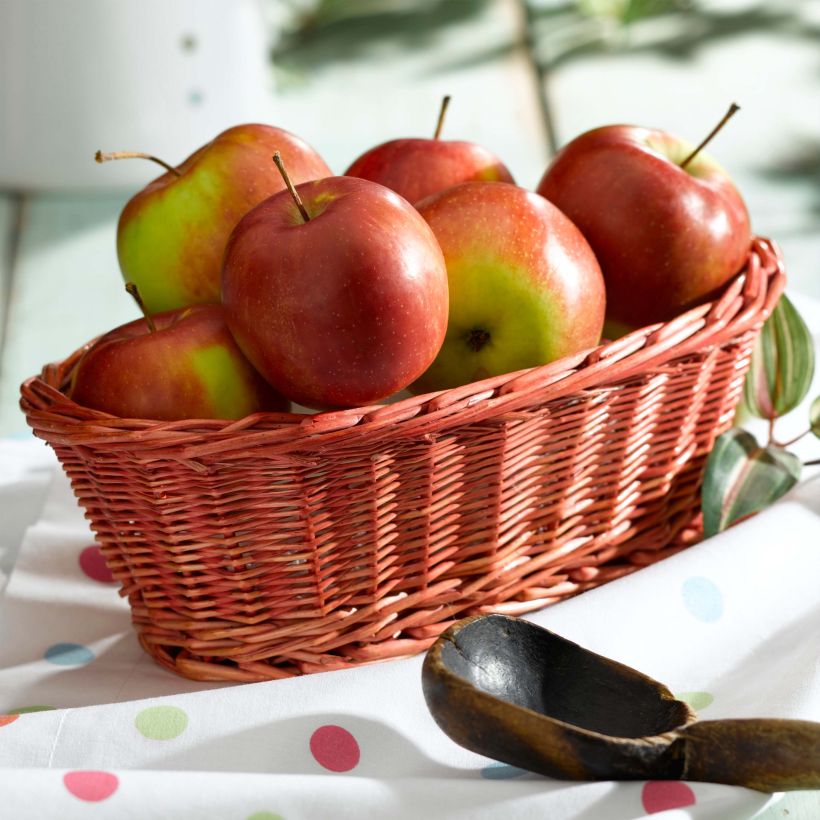

Plant habit
Fruit
Flowering
Foliage
Botanical data
Malus
domestica
Pomme des Moissons® Delprivale
Rosaceae
Apple, Orchard apple, Table apple, Cultivated apple
Cultivar or hybrid
M106 (Ready-to-plant root ball - Goblet)
Other Apple trees
Planting and care
Choose a sunny location for your Delprivale Harvest Apple Tree; the soil can be slightly chalky or acidic but not excessively. Dig a wide planting hole at least three times the size of the root ball. Simultaneously add organic matter (potting soil, compost...) and a base fertiliser such as bonemeal. Do not bury the graft collar. Stake if necessary. Water abundantly, even in winter, even if it rains. Fruit trees are ideally planted between October and March, outside of the freezing period. Container-grown plants can be planted all year round except during extreme heat or frost periods.
In winter, you can add a small handful of wood ash, rich in potash, to improve fruiting. Watch out for possible aphid attacks during the season. A white powdery fungus, powdery mildew, may appear on the leaves in summer, but it does not harm fruit development in gardens. Harvest takes place in September. Only keep the picked fruits. Store apples with the stem pointing downwards, on shelves or in crates. Choose a place that is preferably completely dark, dry, and cool but frost-free.
Planting period
Intended location
Care
-
, onOrder confirmed
Reply from on Promesse de fleurs
Georges Delbard fruit trees
Haven't found what you were looking for?
Hardiness is the lowest winter temperature a plant can endure without suffering serious damage or even dying. However, hardiness is affected by location (a sheltered area, such as a patio), protection (winter cover) and soil type (hardiness is improved by well-drained soil).

Photo Sharing Terms & Conditions
In order to encourage gardeners to interact and share their experiences, Promesse de fleurs offers various media enabling content to be uploaded onto its Site - in particular via the ‘Photo sharing’ module.
The User agrees to refrain from:
- Posting any content that is illegal, prejudicial, insulting, racist, inciteful to hatred, revisionist, contrary to public decency, that infringes on privacy or on the privacy rights of third parties, in particular the publicity rights of persons and goods, intellectual property rights, or the right to privacy.
- Submitting content on behalf of a third party;
- Impersonate the identity of a third party and/or publish any personal information about a third party;
In general, the User undertakes to refrain from any unethical behaviour.
All Content (in particular text, comments, files, images, photos, videos, creative works, etc.), which may be subject to property or intellectual property rights, image or other private rights, shall remain the property of the User, subject to the limited rights granted by the terms of the licence granted by Promesse de fleurs as stated below. Users are at liberty to publish or not to publish such Content on the Site, notably via the ‘Photo Sharing’ facility, and accept that this Content shall be made public and freely accessible, notably on the Internet.
Users further acknowledge, undertake to have ,and guarantee that they hold all necessary rights and permissions to publish such material on the Site, in particular with regard to the legislation in force pertaining to any privacy, property, intellectual property, image, or contractual rights, or rights of any other nature. By publishing such Content on the Site, Users acknowledge accepting full liability as publishers of the Content within the meaning of the law, and grant Promesse de fleurs, free of charge, an inclusive, worldwide licence for the said Content for the entire duration of its publication, including all reproduction, representation, up/downloading, displaying, performing, transmission, and storage rights.
Users also grant permission for their name to be linked to the Content and accept that this link may not always be made available.
By engaging in posting material, Users consent to their Content becoming automatically accessible on the Internet, in particular on other sites and/or blogs and/or web pages of the Promesse de fleurs site, including in particular social pages and the Promesse de fleurs catalogue.
Users may secure the removal of entrusted content free of charge by issuing a simple request via our contact form.


































